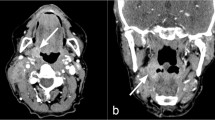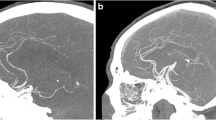Abstract
Introduction
The aim of this study was to determine the effect of different volumes of contrast material with and without a saline chaser on tissue enhancement in multidetector row CT (MDCT) of the head and neck.
Methods
In a blind prospective fashion, 120 patients were randomized into the following four groups: group 1, 80 ml contrast material administered at a flow rate of 2.0 ml/s; group 2, 80 ml followed by 40 ml saline at 2.0 ml/s; group 3, 60 ml at 1.5 ml/s; and group 4, 60 ml followed by 30 ml saline at 1.5 ml/s. The attenuation values of the carotid artery, internal jugular vein, and muscle were measured at an interval of 1.5 s in each patient. The degree of perivenous artifacts was subjectively assessed.
Results
Mean attenuation values in the carotid artery and internal jugular vein were significantly higher in groups 1 and 2 than in groups 3 and 4. The width of the diagnostic window (both carotid and jugular enhancement >150 HU) were significantly longer in groups 1 and 2 than in groups 3 and 4. The addition of a saline chaser did not result in improved vascular enhancement or a wider diagnostic window, but reduced perivenous artifacts, compared with using contrast material alone.
Conclusion
Reduction of contrast material from 80 to 60 ml results in insufficient enhancement of neck vessels. In addition, the benefit of a saline chaser technique is not obvious except for its ability to reduce perivenous artifacts.





Similar content being viewed by others
References
Lasser EC, Lyon SG, Berry ML (1997) Reports on contrast media reactions: analysis of data from reports to the U.S. Food and drug administration. Radiology 203:605–610
Tublin ME, Murphy ME, Tessler FN (1998) Current concepts in contrast media-induced nephropathy. AJR Am J Roentgenol 171:933–939
Spreer J, Krahe T, Jung G, Lackner K (1995) Spiral versus conventional CT in routine examinations of the neck. J Comput Assist Tomogr 19:905–910
Harris EW, LaMarca AJ, Kondroski EM, Murtagh FR, Clark RA (1996) Enhanced CT of the neck: improved visualization of lesions with delayed imaging. AJR Am J Roentgenol 167:1057–1058
Feuerbach S, Lorenz W, Klose KJ, et al (1996) Administration of contrast medium in spiral computed tomography: results of a consensus conference. Rofo 164:158–165
Sakai O, Nakashima N, Shibayama C, Shinozaki T, Furuse M (1997) Asymmetrical or heterogeneous enhancement of the internal jugular veins in contrast-enhanced CT of the head and neck. Neuroradiology 39:292–295
Groell R, Willfurth P, Schaffler GJ, et al (1999) Contrast-enhanced spiral CT of the head and neck: comparison of contrast material injection rates. AJNR Am J Neuroradiol 20:1732–1736
Keberle M, Tschammler A, Hahn D (2002) Single-bolus technique for spiral CT of laryngopharyngeal squamous cell carcinoma: comparison of different contrast material volumes, flow rates, and start delays. Radiology 224:171–176
Hopper KD, Mosher TJ, Kasales CJ, et al (1997) Thoracic spiral CT: delivery of contrast material pushed with injectable saline solution in a power injector. Radiology 205:269–271
Haage P, Schmitz-Rode T, Hubner D, et al (2000) Reduction of contrast material dose and artifacts by a saline flush using a double power injector in helical CT of the thorax. AJR Am J Roentgenol 174:1049–1053
Irie T, Kajitani M, Yamaguchi M, et al (2002) Contrast-enhanced CT with saline flush technique using two automated injectors: how much contrast medium does it save? J Comput Assist Tomogr 26:287–291
Sadick M, Lehmann KJ, Diehl SJ, et al (1997) Bolus tracking and NaCl bolus in biphasic spiral CT of the abdomen (in German). Rofo 167:371–376
Dorio PJ, Lee FT, Henseler KP, et al (2003) Using a saline chaser to decrease contrast media in abdominal CT. AJR Am J Roentgenol 180:929–934
Cademartiri F, van der Lugt A, Luccichenti G, Pavone P, Krestin GP (2002) Parameters affecting bolus geometry in CTA: a review. J Comput Assist Tomogr 26:598–607
Cademartiri F, Mollet N, van der Lugt A, et al (2004) Non-invasive 16-row multislice CT coronary angiography: usefulness of saline chaser. Eur Radiol 14:178–183
Schoellnast H, Tillich M, Deutschmann MJ, Deutschmann HA, Schaffler GJ, Portugaller HR (2004) Aortoiliac enhancement during computed tomography angiography with reduced contrast material dose and saline solution flush: influence on magnitude and uniformity of the contrast column. Invest Radiol 39:20–26
de Monyé C, Cademartiri F, de Weert TT, Siepman DAM, Dippel DWJ, van Der Lugt A (2005) Sixteen-detector row CT angiography of carotid arteries: comparison of different volumes of contrast material with and without a bolus chaser. Radiology 237:555–562
Rubin GD, Shiau MC, Leung AN, Kee ST, Logan LJ, Sofilos MC (2000) Aorta and iliac arteries: single versus multiple detector-row helical CT angiography. Radiology 215:670–676
Platt JF, Reige KA, Ellis JH (1999) Aortic enhancement during abdominal CT angiography: correlation with test injections, flow rates, and patient demographics. AJR Am J Roentgenol 172:53–56
Macari M, Israel GM, Berman P, et al (2001) Infrarenal abdominal aortic aneurysm at multi-detector row CT angiography: intravascular enhancement without a timing acquisition. Radiology 220:519–523
Ho LM, Nelson RC, Thomas J, Gimenez EI, DeLong DM (2004) Abdominal aortic aneurysms at multi-detector row helical CT: optimization with interactive determination of scanning delay and contrast medium dose. Radiology 232:854–859
Suzuki H, Oshima H, Shiraki N, Ikeya C, Shibamoto Y (2004) Comparison of two contrast materials with different iodine concentrations in enhancing the density of the aorta, portal vein and liver at multi-detector row CT: a randomized study. Eur Radiol 14:2099–2104
Ertl-Wagner BB, Hoffmann RT, Bruning R, et al (2004) Multi-detector row CT angiography of the brain at various kilovoltage settings. Radiology 231:528–535
Ertl-Wagner BB, Bruning R, Blume J, et al (2005) Prospective, multireader evaluation of image quality and vascular delineation of multislice CT angiography of the brain. Eur Radiol 15:1051–1059
Tanaka T, Uemura K, Takahashi M, et al (1993) Compression of the left brachiocephalic vein: cause of high signal intensity of the left sigmoid sinus and internal jugular vein on MR images. Radiology 188:355–361
Conflict of interest statement
We declare that we have no conflict of interest.
Author information
Authors and Affiliations
Corresponding author
Rights and permissions
About this article
Cite this article
Yoon, D.Y., You, S.Y., Choi, C.S. et al. Multi-detector row CT of the head and neck: comparison of different volumes of contrast material with and without a saline chaser. Neuroradiology 48, 935–942 (2006). https://doi.org/10.1007/s00234-006-0146-4
Received:
Accepted:
Published:
Issue Date:
DOI: https://doi.org/10.1007/s00234-006-0146-4




